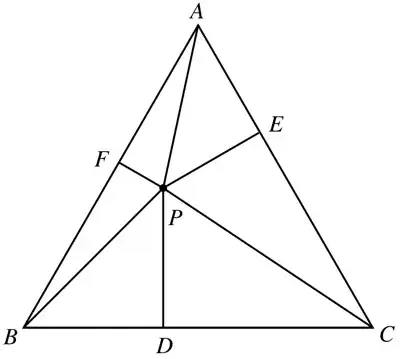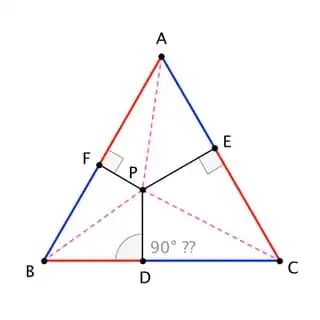For simplicity, let the sides of the triangle be $1$.
$\hspace{3.5cm}$
Looking at the areas of the sub-triangles, we get
$$
\begin{align}
|\,\triangle ABP\,|&=\frac12|\,\overline{FP}\,|\times|\,\overline{AB}\,|=\frac12|\,\overline{FP}\,|\\
|\,\triangle BCP\,|&=\frac12|\,\overline{DP}\,|\times|\,\overline{BC}\,|=\frac12|\,\overline{DP}\,|\tag{1}\\
|\,\triangle CAP\,|&=\frac12|\,\overline{EP}\,|\times|\,\overline{CA}\,|=\frac12|\,\overline{EP}\,|
\end{align}
$$
Summing these, we get
$$
|\,\overline{FP}\,|+|\,\overline{DP}\,|+|\,\overline{EP}\,|=2|\,\triangle ABC\,|=\frac{\sqrt3}{2}\tag{2}
$$
Rename the distances in question as $x$, $y$, and $z$.
$\hspace{2.3cm}$
Considering the vertical distances on sides $x$ and $y$ and then repeating the same for the other side pairs:
$$
\begin{align}
\frac{\sqrt3}{2}x+\frac12h_x&=\frac{\sqrt3}{2}(1-y)+\frac12h_y\\
\frac{\sqrt3}{2}y+\frac12h_y&=\frac{\sqrt3}{2}(1-z)+\frac12h_z\tag{3}\\
\frac{\sqrt3}{2}z+\frac12h_z&=\frac{\sqrt3}{2}(1-x)+\frac12h_x
\end{align}
$$
Adding these and cancelling results in
$$
x+y+z=\frac32\tag{4}
$$
That is
$$
|\,\overline{FA}\,|+|\,\overline{DB}\,|+|\,\overline{EC}\,|=\frac32\tag{5}
$$
Thus, $(2)$ and $(5)$ yield
$$
\frac{|\,\overline{FP}\,|+|\,\overline{DP}\,|+|\,\overline{EP}\,|}{|\,\overline{FA}\,|+|\,\overline{DB}\,|+|\,\overline{EC}\,|}=\frac1{\sqrt3}\tag{6}
$$


